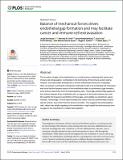Balance of mechanical forces drives endothelial gap formation and may facilitate cancer and immune-cell extravasation
Author(s)
Escribano, Jorge; Chen, Michelle B.; Moeendarbary, Emad; Kamm, Roger D.; Spill, Fabian
DownloadPublished version (2.271Mb)
Publisher with Creative Commons License
Publisher with Creative Commons License
Creative Commons Attribution
Terms of use
Metadata
Show full item recordAbstract
The formation of gaps in the endothelium is a crucial process underlying both cancer and immune cell extravasation, contributing to the functioning of the immune system during infection, the unfavorable development of chronic inflammation and tumor metastasis. Here, we present a stochastic-mechanical multiscale model of an endothelial cell monolayer and show that the dynamic nature of the endothelium leads to spontaneous gap formation, even without intervention from the transmigrating cells. These gaps preferentially appear at the vertices between three endothelial cells, as opposed to the border between two cells. We quantify the frequency and lifetime of these gaps, and validate our predictions experimentally. Interestingly, we find experimentally that cancer cells also preferentially extrava-sate at vertices, even when they first arrest on borders. This suggests that extravasating cells, rather than initially signaling to the endothelium, might exploit the autonomously forming gaps in the endothelium to initiate transmigration.
Date issued
2019-05-02Department
Massachusetts Institute of Technology. Department of Biological Engineering; Massachusetts Institute of Technology. Department of Mechanical EngineeringJournal
PloS one
Publisher
Public Library of Science (PLoS)
Citation
Escribano, Jorge et al. "Balance of mechanical forces drives endothelial gap formation and may facilitate cancer and immune-cell extravasation." PloS one 15 (2010): e1006395 © 2019 The Author(s)
Version: Final published version
ISSN
1553-7358
Keywords
Ecology, Modelling and Simulation, Computational Theory and Mathematics, Genetics, Ecology, Evolution, Behavior and Systematics, Molecular Biology, Cellular and Molecular Neuroscience